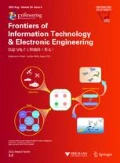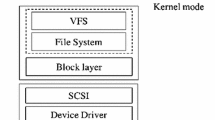Abstract
Performance and energy consumption of a solid state disk (SSD) highly depend on file systems and I/O schedulers in operating systems. To find an optimal combination of a file system and an I/O scheduler for SSDs, we use a metric called the aggregative indicator (AI), which is the ratio of SSD performance value (e.g., data transfer rate in MB/s or throughput in IOPS) to that of energy consumption for an SSD. This metric aims to evaluate SSD performance per energy consumption and to study the SSD which delivers high performance at low energy consumption in a combination of a file system and an I/O scheduler. We also propose a metric called Cemp to study the changes of energy consumption and mean performance for an Intel SSD (SSD-I) when it provides the largest AI, lowest power, and highest performance, respectively. Using Cemp, we attempt to find the combination of a file system and an I/O scheduler to make SSD-I deliver a smooth change in energy consumption. We employ Filebench as a workload generator to simulate a wide range of workloads (i.e., varmail, fileserver, and webserver), and explore optimal combinations of file systems and I/O schedulers (i.e., optimal values of AI) for tested SSDs under different workloads. Experimental results reveal that the proposed aggregative indicator is comprehensive for exploring the optimal combination of a file system and an I/O scheduler for SSDs, compared with an individual metric.
Similar content being viewed by others
References
Agrawal, N., Bolosky, W.J., Douceur, J.R., et al., 2007. A five-year study of file-system metadata. ACM Trans. Storage, 3(3), Article 9. [doi:10.1145/1288783.1288788]
Agrawal, N., Prabhakaran, V., Wobber, T., et al., 2008. Design tradeoffs for SSD performance. USENIX Annual Technical Conf., p.57–70.
Appleton, R., 1997. Kernel korner: a non-technical look inside the EXT2 file system. Linux J., 1997(40es), Article 19.
Ban, A., 1995. Flash File System. US Patent 5 404 485.
Bux, W., 2009. Performance Evaluation of the Write Operation in Flash-Based Solid-State Drives. Technical Report No. RZ3757, IBM Research, Zurich, Rschlikon.
Chen, F., Koufaty, D.A., Zhang, X.D., 2009. Understanding intrinsic characteristics and system implications of flash memory based solid state drives. Proc. 11th Int. Joint Conf. on Measurement and Modeling of Computer Systems, p.181–192. [doi:10.1145/1555349.1555371]
Desnoyers, P., 2010. Empirical evaluation of NAND flash memory performance. ACM SIGOPS Oper. Syst. Rev., 44(1):50–54. [doi:10.1145/1740390.1740402]
Dirik, C., Jacob, B., 2009. The performance of PC solidstate disks (SSDs) as a function of bandwidth, concurrency, device architecture, and system organization. ACM SIGARCH Comput. Archit. News, 37(3):279–289. [doi:10.1145/1555815.1555790]
Gupta, A., Kim, Y., Urgaonkar, B., 2009. DFTL: a flash translation layer employing demand-based selective caching of page-level address mappings. Proc. 14th Int. Conf. on Architectural Support for Programming Languages and Operating Systems, p.229–240. [doi:10.1145/1508244.1508271]
Heger, D.A., Quinn, R., 2010. Linux 2.6 IO performance analysis, quantification, and optimization. Proc. Int. Conf. for Performance and Capacity Management-CMG.
Hu, X.Y., Haas, R., 2010. The Fundamental Limit of Flash Random Write Performance: Understanding, Analysis and Performance Modelling. Technical Report No. RZ3771, IBM Research, Zurich, Rschlikon.
Huang, H.H., Li, S., Szalay, A., et al., 2011. Performance modeling and analysis of flash-based storage devices. IEEE 27th Symp. on Mass Storage Systems and Technologies, p.1–11. [doi:10.1109/MSST.2011.5937213]
Iliadis, I., 2010. Performance of the Greedy Garbage-Collection Scheme in Flash-Based Solid-State Drives. Technical Report No. RZ3769, IBM Research, Zurich, Rschlikon.
Jung, D., Chae, Y.H., Jo, H., et al., 2007. A group-based wear-leveling algorithm for large-capacity flash memory storage systems. Proc. Int. Conf. on Compilers, Architecture, and Synthesis for Embedded Systems, p.160–164. [doi:10.1145/1289881.1289911]
Jung, M., Prabhakar, R., Kandemir, M.T., 2012. Taking garbage collection overheads off the critical path in SSDs. Proc. 13th Int. Middleware Conf., p.164–186. [doi:10.1007/978-3-642-35170-9_9]
Kang, J.U., Jo, H., Kim, J.S., et al., 2006. A superblockbased flash translation layer for NAND flash memory. Proc. 6th ACM & IEEE Int. Conf. on Embedded Software, p.161–170. [doi:10.1145/1176887.1176911]
Kim, J., Kim, J.M., Noh, S.H., et al., 2002. A spaceefficient flash translation layer for CompactFlash systems. IEEE Trans. Consum. Electron., 48(2):366–375. [doi:10.1109/TCE.2002.1010143]
Kim, J., Oh, Y., Kim, E., et al., 2009. Disk schedulers for solid state drivers. Proc. 7th ACM Int. Conf. on Embedded Software, p.295–304. [doi:10.1145/1629335.1629375]
Kim, J., Seo, S., Jung, D., et al., 2012. Parameter-aware I/O management for solid state disks (SSDs). IEEE Trans. Comput., 61(5):636–649. [doi:10.1109/TC.2011.76]
Kim, J.H., Jung, D., Kim, J.S., et al., 2009. A methodology for extracting performance parameters in solid state disks (SSDs). IEEE Int. Symp. on Modeling, Analysis & Simulation of Computer and Telecommunication Systems, p.1–10. [doi:10.1109/MASCOT.2009.5366154]
Kim, Y., Tauras, B., Gupta, A., et al., 2009. FlashSim: a simulator for NAND flash-based solid-state drives. 1st Int. Conf. on Advances in System Simulation, p.125–131. [doi:10.1109/SIMUL.2009.17]
Konishi, R., Amagai, Y., Sato, K., et al., 2006. The Linux implementation of a log-structured file system. ACM SIGOPS Oper. Syst. Rev., 40(3):102–107. [doi:10.1145/1151374.1151375]
Lee, J.D., Hur, S.H., Choi, J.D., 2002. Effects of floatinggate interference on NAND flash memory cell operation. IEEE Electron Dev. Lett., 23(5):264–266. [doi:10.1109/55.998871]
Lee, S., Shin, D., Kim, Y.J., et al., 2008. LAST: localityaware sector translation for NAND flash memory-based storage systems. ACM SIGOPS Oper. Syst. Rev., 42(6):36–42. [doi:10.1145/1453775.1453783]
Lee, S.W., Park, D.J., Chung, T.S., et al., 2007. A log buffer-based flash translation layer using fullyassociative sector translation. ACM TECS, 6(3), Article 18. [doi:10.1145/1275986.1275990]
Lee, S.W., Moon, B., Park, C., et al., 2008. A case for flash memory SSD in enterprise database applications. Proc. ACM SIGMOD Int. Conf. on Management of Data, p.1075–1086. [doi:10.1145/1376616.1376723]
Lu, Y., Shu, J., Zheng, W., et al., 2013. Extending the lifetime of flash-based storage through reducing write amplification from file systems. Proc. 11th USENIX Conf. on File and Storage Technologies, p.257–270.
Luo, J., Zhao, G., 2007. Solid State Hard Disk. US Patent 764 231.
Maghraoui, K.E., Kandiraju, G., Jann, J., et al., 2010. Modeling and simulating flash based solid-state disks for operating systems. Proc. 1st Joint WOSP/SIPEW Int. Conf. on Performance Engineering, p.15–26. [doi:10.1145/1712605.1712611]
Masuoka, F., Momodomi, M., Iwata, Y., et al., 1987. New ultra high density EPROM and flash EEPROM with NAND structure cell. Int. Electron Devices Meeting, p.552–555. [doi:10.1109/IEDM.1987.191485]
McKusick, M.K., Joy, W.N., Leffler, S.J., et al., 1984. A fast file system for UNIX. ACM Trans. Comput. Syst., 2(3):181–197. [doi:10.1145/989.990]
Moallem, M., 2008. A Study on the Performance Evaluation of Linux I/O Schedulers. MS Thesis, University of Toronto, Canada.
Mohan, V., Gurumurthi, S., Stan, M.R., 2010. FlashPower: a detailed power model for NAND flash memory. Proc. Conf. & Exhibition on Design, Automation & Test in Europe, p.502–507. [doi:10.1109/DATE.2010.5457154]
Murugan, M., Du, D.H.C, 2011. Rejuvenator: a static wear leveling algorithm for NAND flash memory with minimized overhead. IEEE 27th Symp. on Mass Storage Systems and Technologies, p.1–12. [doi:10.1109/MSST.2011.5937225]
O’Brien, K., Salyers, D.C., Striegel, A.D., et al., 2008. Power and performance characteristics of USB flash drives. Int. Symp. on a World of Wireless, Mobile and Multimedia Networks, p.1–4. [doi:10.1109/WOWMOM.2008.4594868]
Park, J., Yoo, S., Lee, S., et al., 2009. Power modeling of solid state disk for dynamic power management policy design in embedded systems. Proc. 7th IFIP Int. Workshop on Software Technologies for Embedded and Ubiquitous Systems, p.24–35. [doi:10.1007/978-3-642-10265-3_3]
Park, S., Shen, K., 2009. A performance evaluation of scientific I/O workloads on flash-based SSDs. IEEE Int. Conf. on Cluster Computing and Workshops, p.1–5. [doi:10.1109/CLUSTR.2009.5289148]
Park, S., Kim, Y., Urgaonkar, B., et al., 2011. A comprehensive study of energy efficiency and performance of flash-based SSD. J. Syst. Archit., 57(4):354–365. [doi:10.1016/j.sysarc.2011.01.005]
Pratt, S.L., Heger, D.A., 2004. Workload dependent performance evaluation of the Linux 2.6 I/O schedulers. Linux Symp.
Riska, A., Larkby-Lahet, J., Riedel, E., 2007. Evaluating block-level optimization through the IO path. USENIX Annual Technical Conf., p.247–260.
Rosenblum, M., Ousterhout, J.K., 1992. The design and implementation of a log-structured file system. ACM Trans. Comput. Syst., 10(1):26–52. [doi:10.1145/146941.146943]
Sehgal, P., Tarasov, V., Zadok, E., 2010. Evaluating performance and energy in file system server workloads. 8th USENIX Conf. on File and Storage Technologies, p.253–266.
Seo, E., Park, S.Y., Urgaonkar, B., 2008. Empirical analysis on energy efficiency of flash-based SSDs. Proc. Conf. on Power Aware Computing and Systems, p.1–5.
Tweedie, S., 2000. Ext3, journaling filesystem. Ottawa Linux Symp., p.24–29.
Wang, H., Huang, P., He, S., et al., 2013. A novel I/O scheduler for SSD with improved performance and lifetime. IEEE 29th Symp. on Mass Storage Systems and Technologies, p.1–5. [doi:10.1109/MSST.2013.6558426]
Wang, R.Y., Anderson, T.E., 1993. xFS: a wide area mass storage file system. Proc. 4th Workshop on Workstation Operating Systems, p.71–78. [doi:10.1109/WWOS.1993.348169]
Wang, Y.K., Goda, K., Nakano, M., et al., 2011. Performance evaluation of flash SSDs in a transaction processing system. IEICE Trans. Inform. Syst., 94(3):602–611. [doi:10.1587/transinf.E94.D.602]
Wei, Q.S., Gong, B., Pathak, S., et al., 2011. WAFTL: a workload adaptive flash translation layer with data partition. IEEE 27th Symp. on Mass Storage Systems and Technologies, p.1–12. [doi:10.1109/MSST.2011.5937217]
Yoo, B., Won, Y., Choi, S., et al., 2011. SSD characterization: from energy consumption’s perspective. 3rd USENIX Workshop on Hot Topics in Storage and File Systems.
Author information
Authors and Affiliations
Corresponding author
Additional information
Project supported by the National Basic Research Program (973) of China (No. 2011CB302303), the National Natural Science Foundation of China (No. 60933002), the National High-Tech R&D Program (863) of China (No. 2013AA013203), and the U.S. National Science Foundation under Grants CCF-0845257 (CAREER), CNS-0917137 (CSR), CNS-0757778 (CSR), CCF-0742187 (CPA), CNS-0831502 (CyberTrust), CNS-0855251 (CRI), OCI-0753305 (CI-TEAM), DUE-0837341 (CCLI), and DUE-0830831 (SFS)
Rights and permissions
About this article
Cite this article
Sun, H., Qin, X. & Xie, Cs. Exploring optimal combination of a file system and an I/O scheduler for underlying solid state disks. J. Zhejiang Univ. - Sci. C 15, 607–621 (2014). https://doi.org/10.1631/jzus.C1300314
Received:
Accepted:
Published:
Issue Date:
DOI: https://doi.org/10.1631/jzus.C1300314




